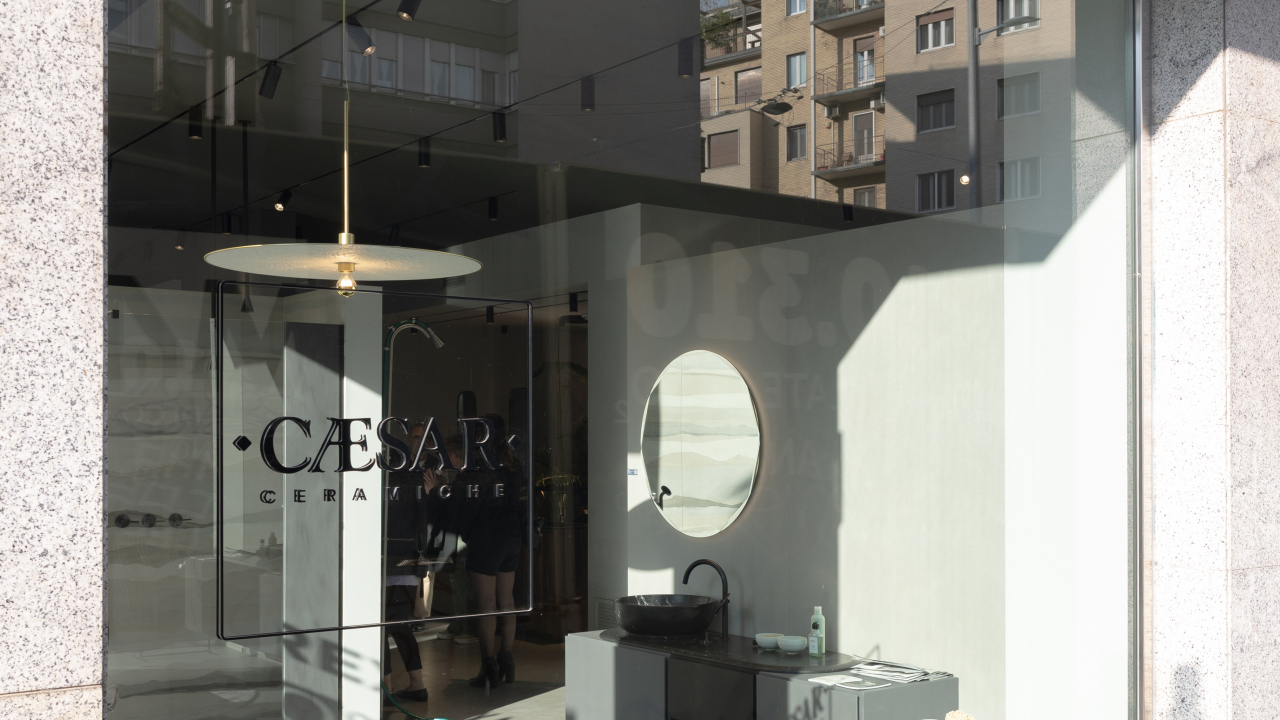The young Milanese designers Finemateria are the protagonists of the 3rd edition of the “Instant of Change” project, which has once again united art, materials and design visions under the roof of the Caesar Urban Lab in via Molino delle Armi, a collaborative multifunctional space by Mo.1950 with Quadrodesign and Rexa.
Ceramiche Caesar had a personal interview with the very young designers Stefano Bassan and Gianluca Sigismondi to get to know them better and understand what lies behind “Tris”, the project presented at the Milano Design Week 2023.
Stefano Bassan
Son of a designer, he breathed “the design career" from an early age, experiencing the week of the Salone del Mobile through the eyes of a child and as a curious game.
Gianluca Sigismondi
Creative by nature, technical for professional declination, he discovered design with university studies and learned the arts of storytelling applied to product design in his first experiences of studying and working with Stefano.
The IED University in Milan has brought them together and the EDIT Napoli project (2020) sealed their entry into the panorama of Italian design.
"We are 2 different professionals, so Finemateria manages to be a good union of two points: sometimes pragmatic, sometimes more creative. We find the meeting point in aesthetics. The advantages of being two people in the studio are to be proactive and undergo the positive influences of each other. Our projects are always the synthesis of the confrontation of two personalities".

Q: Finemateria: where does this peculiar name come from?
"We wanted the name to be like a manifesto of how we work; first we start from the material, we investigate it, we understand it and its possibilities; then we work on the drawing".
Q: With Instant of Change you worked with porcelain stoneware: what did you expect to find inside the production plant in Fiorano Modenese?
Gianluca: "I am very passionate about process, technologies, production. I really like to see how the organisation is, the optimization times, the maximisation of the production line. And then what really surprised me are the possibilities of crafting the surface of the ceramic material to enhance the final product and what I think is the most creative room of the plant: the laboratory. Everything that has to do with 3D printing and the latest design technologies fascinate me".
Stefano: "My impression was that we were going to see a huge production plan. After the visit I definitely understood that we needed to interpret and transmit all that into the project, by respecting the Company's values. This opportunity also opened our minds to new ideas that may perhaps lead to something in the future or in any case to a dialogue".
With these inputs after the visit of the plant, the young designers decided to impress the aesthetic and technical value of Caesar porcelain ceramics working on the concept of 3D surfaces for “Tris”:
"We made a fairly difficult three-dimensional, 16-sided design, a very clean, simple volume, but still not quite easy to create."
Q: How was your approach to a (relatively) simple material as porcelain stoneware?
"Working with ceramics is like history that marries innovation, in the sense that the fairly traditional approach has undergone huge improvements in the last few years, which made the material exponentially more performing, expanding its applications”.

Q: For the "Tris" project you have chosen the PRIMA collection: why?
"At the end of the day, it is a natural material. We liked that naturalness. Porcelain stoneware is innovative yet historical. We chose neutral shades and tones to deliver these concepts”
The Company's offer is wide. During the factory visit we had the opportunity to touch all of them and we opted for the collection PRIMA first of all for its naturalness, the clay sensations it evoked, and these earthy, neutral colors which are somewhat reminiscent of the raw material, the historicity of it. But then the finished object evokes an industrial imaginary (however complex to produce) and therefore a contrast emerges between the sensations that the ceramic material gives, its shape and the way it was assembled".
Q: "Tris" is a design project but also a game: what is the idea behind it?
The game unconsciously makes people discover and learn on a sensory level, on a relational level, on a logical level.
The meeting with the Companies Ceramiche Caesar, Rexa and Quadrodesign was emblematic from a gaming point of view and from the theme side - "Instant of change". When the player plays on "Tris" he touches and moves the objects, he changes their position.
“We wanted the materials to touch each other and to create a dialogue between them: three companies, three materials, three pawns in line to win. We can say that the "Tris" project coordinated the companies to make them collaborate harmoniously with a product that represented and respected the values of all of them.
“And then the beauty was also precisely that the game became the element of interaction for the public who visited the showroom to play with “Tris”, having therefore a more intense memory of those instants”.

Credits: Cristina Sinelli
